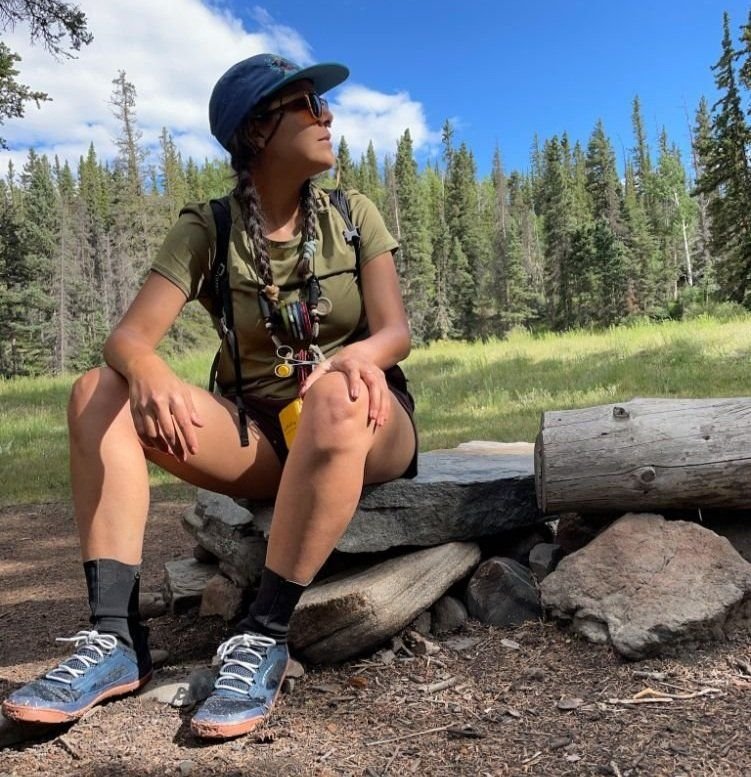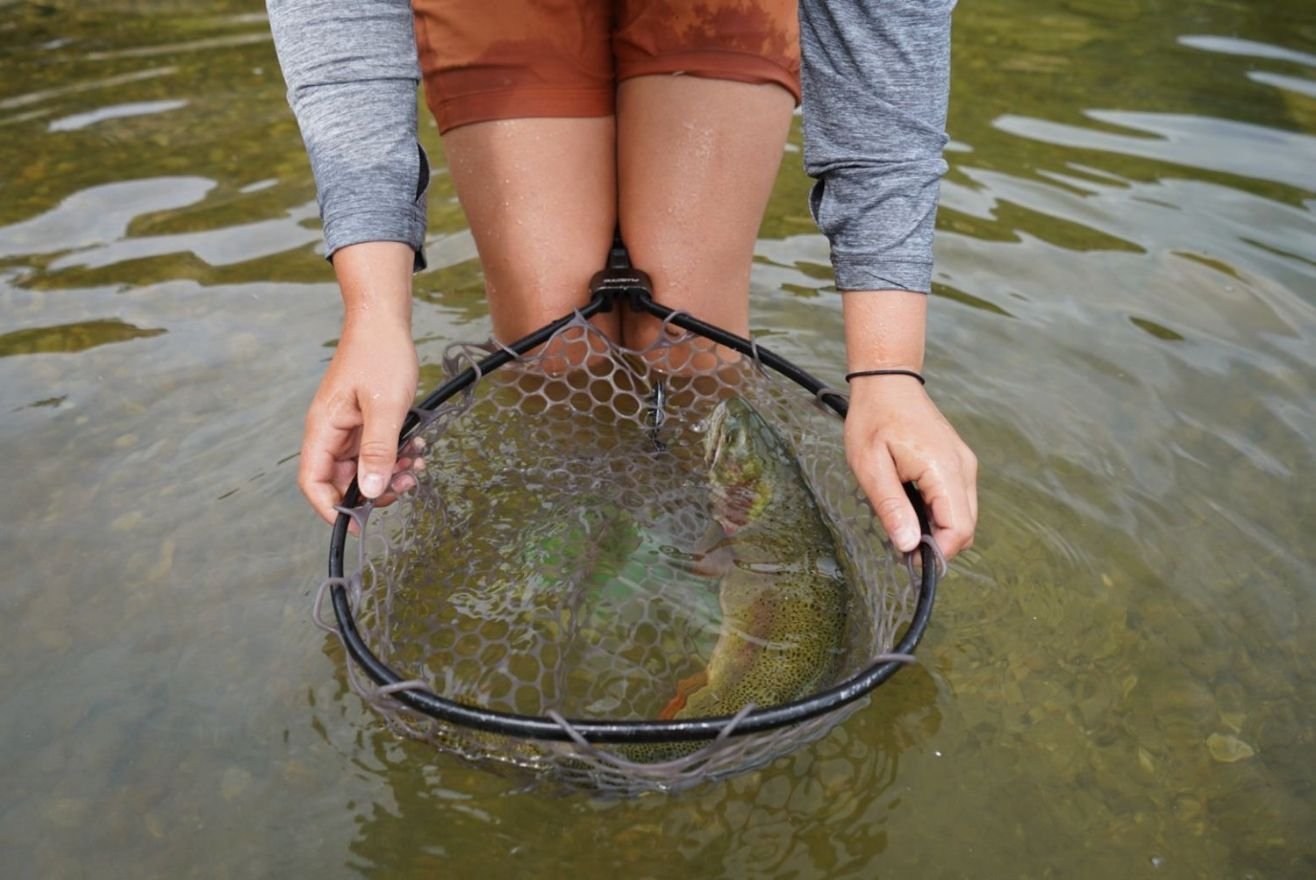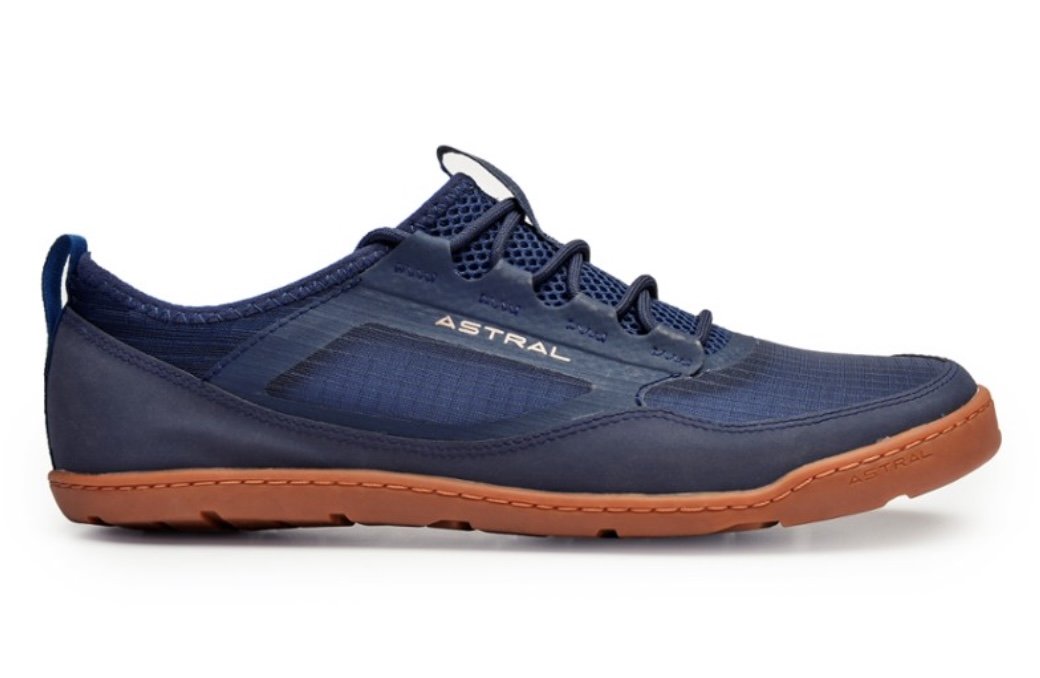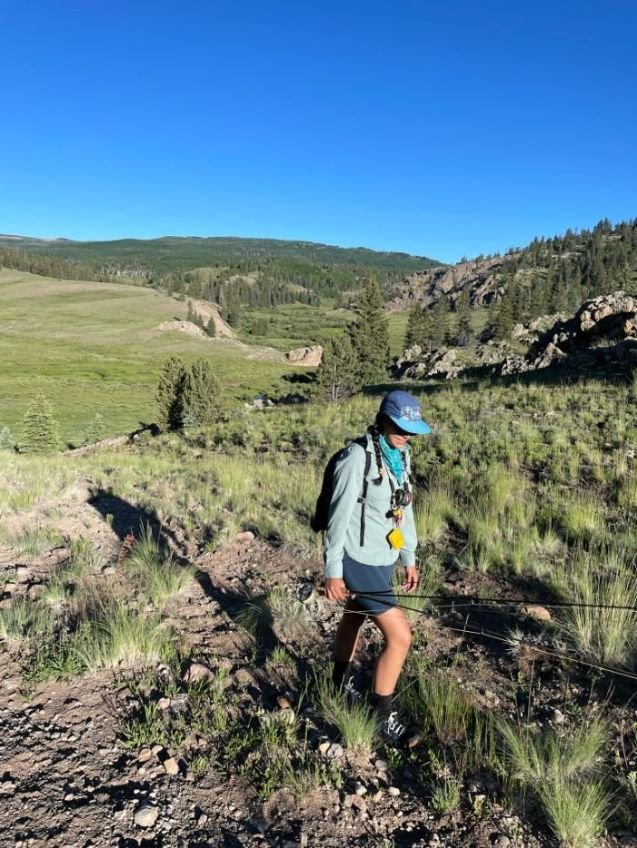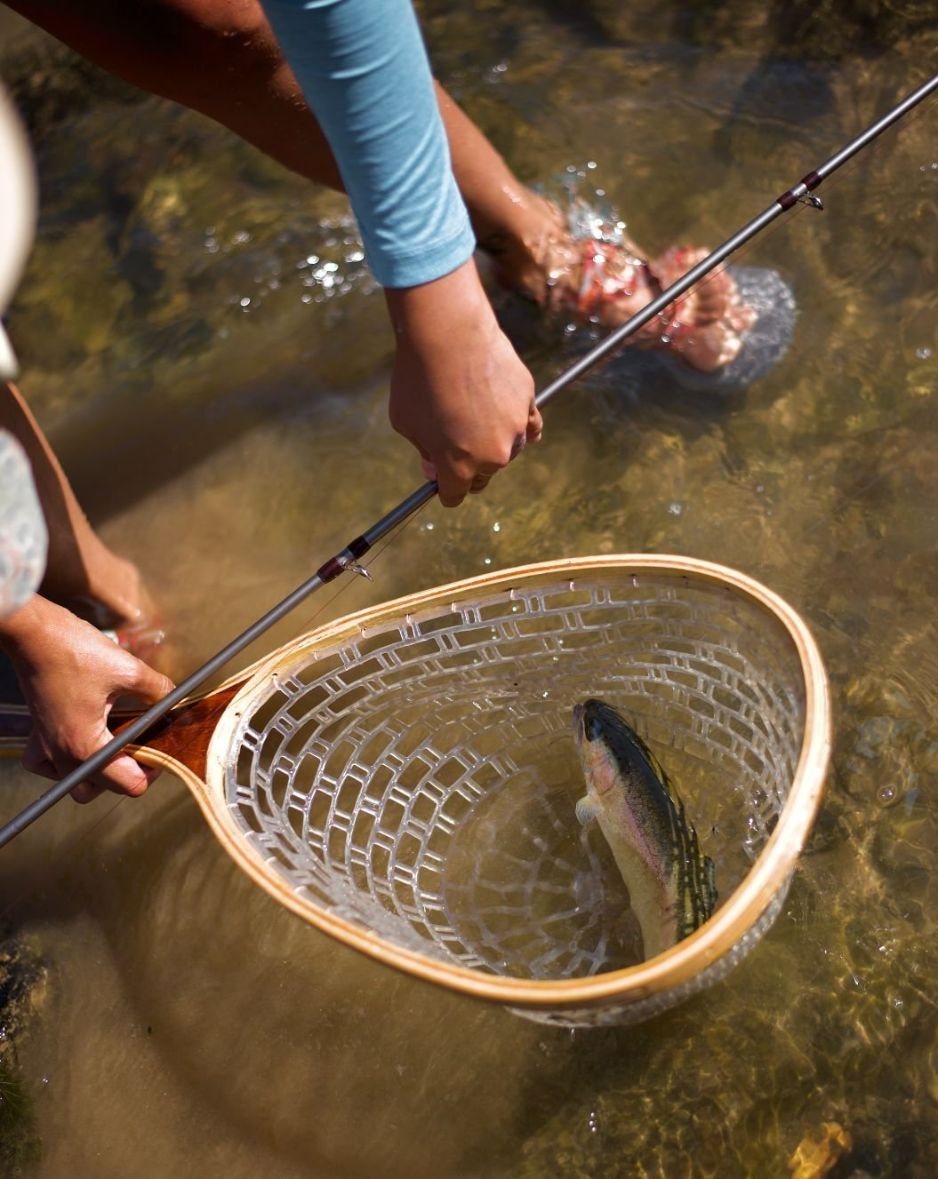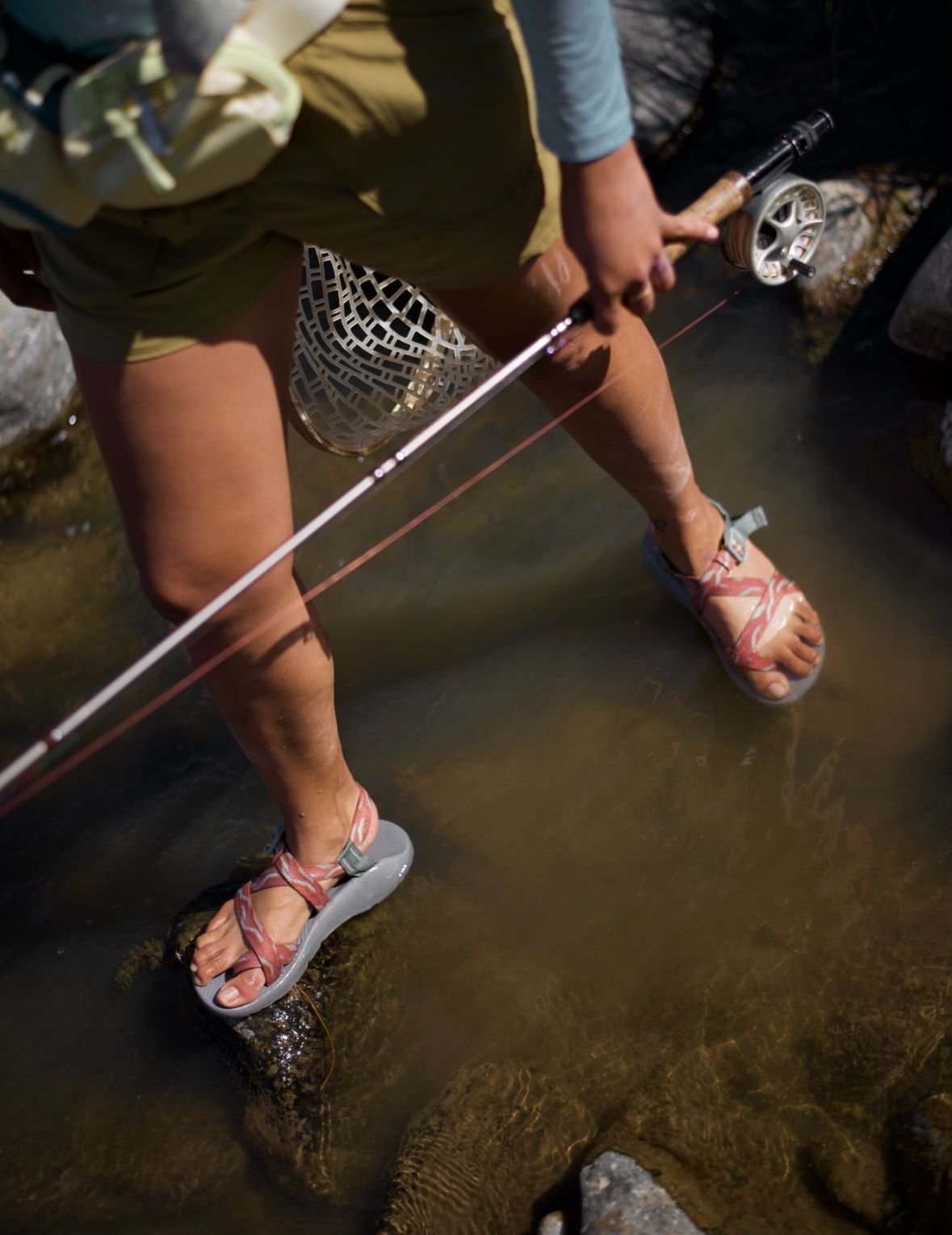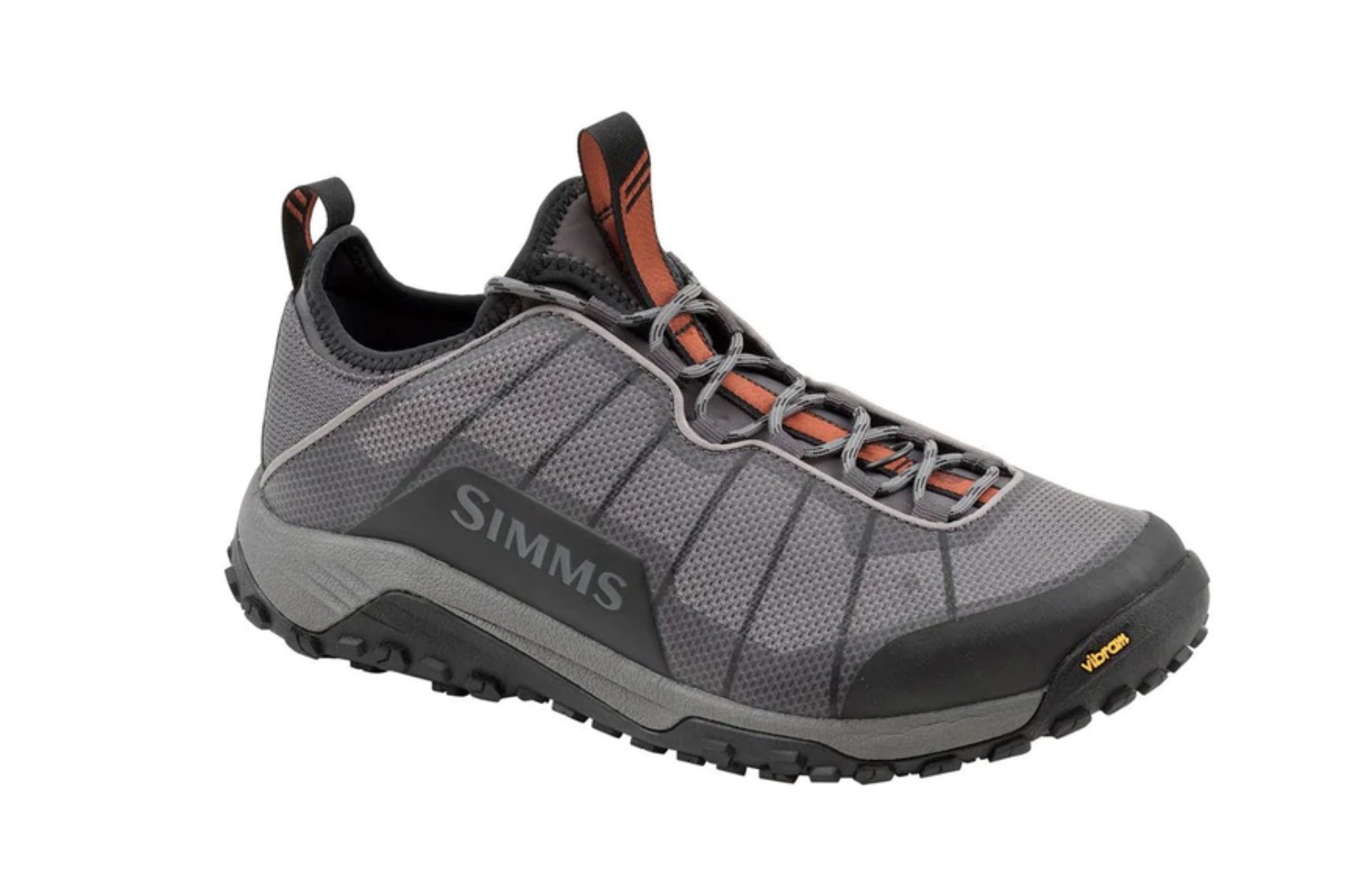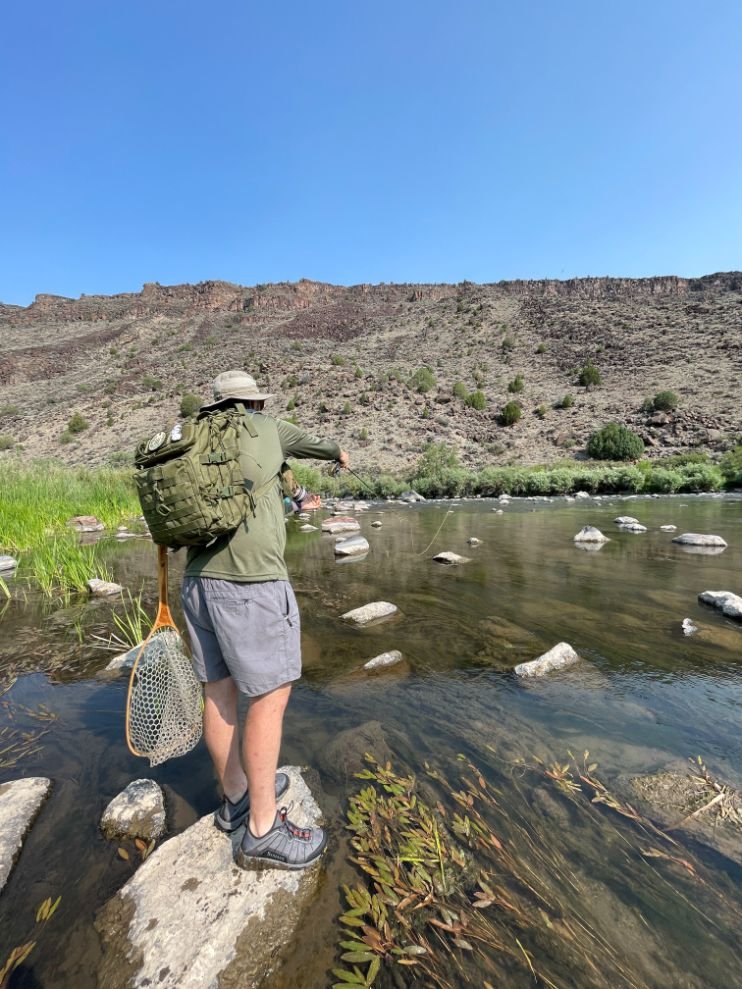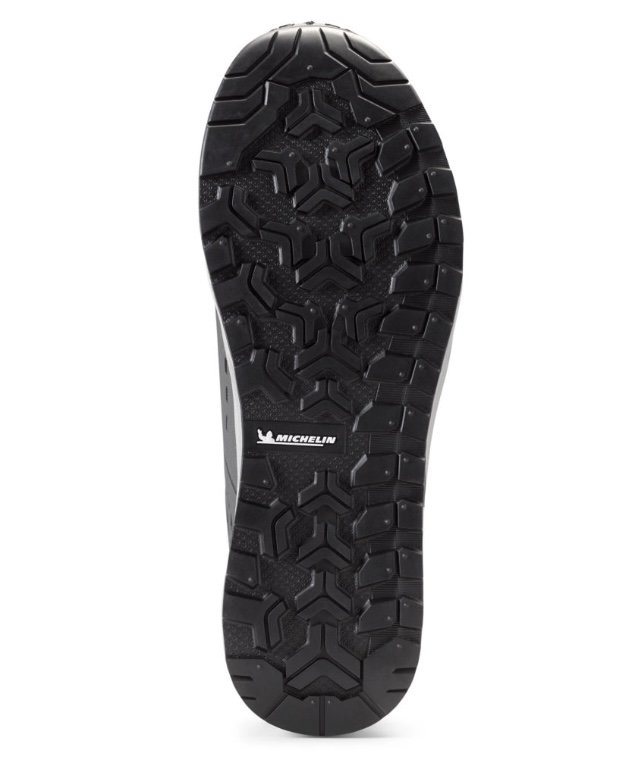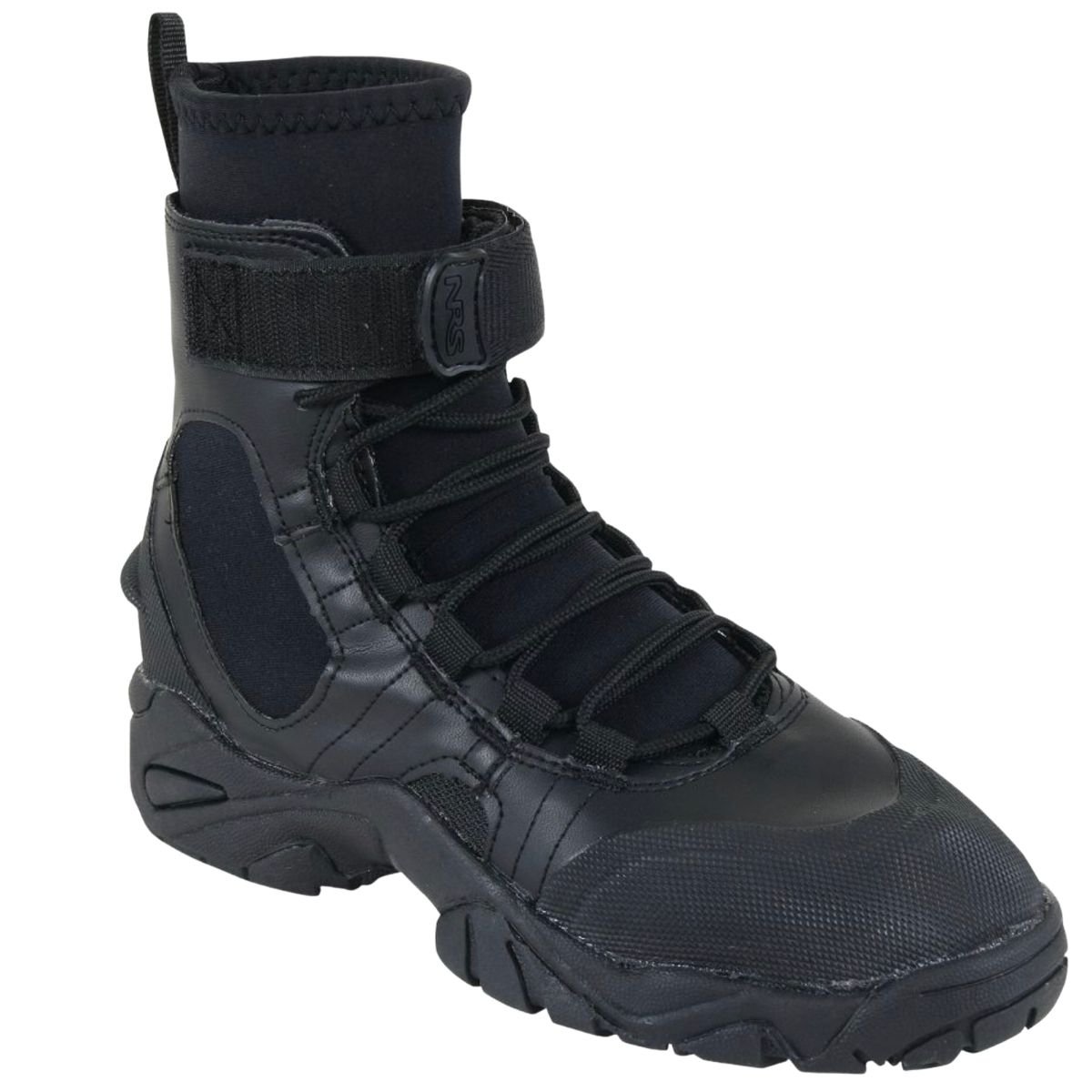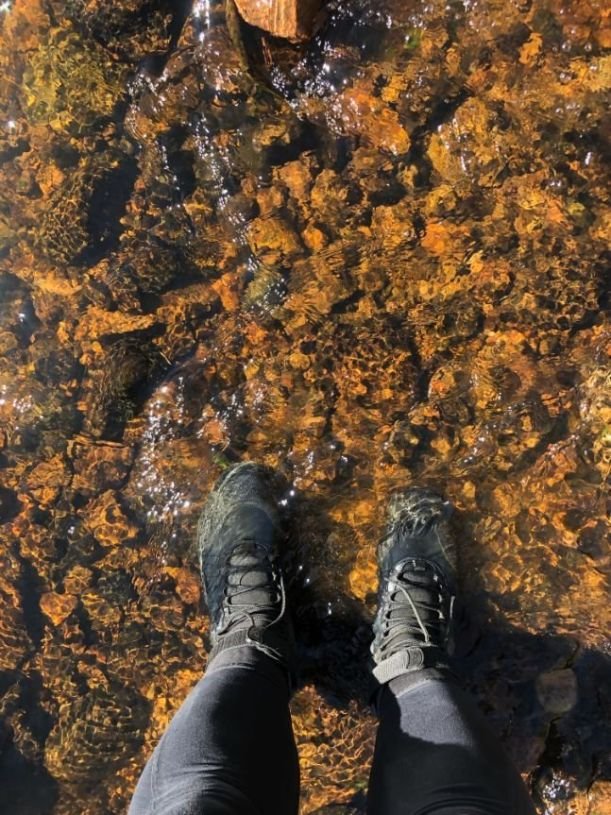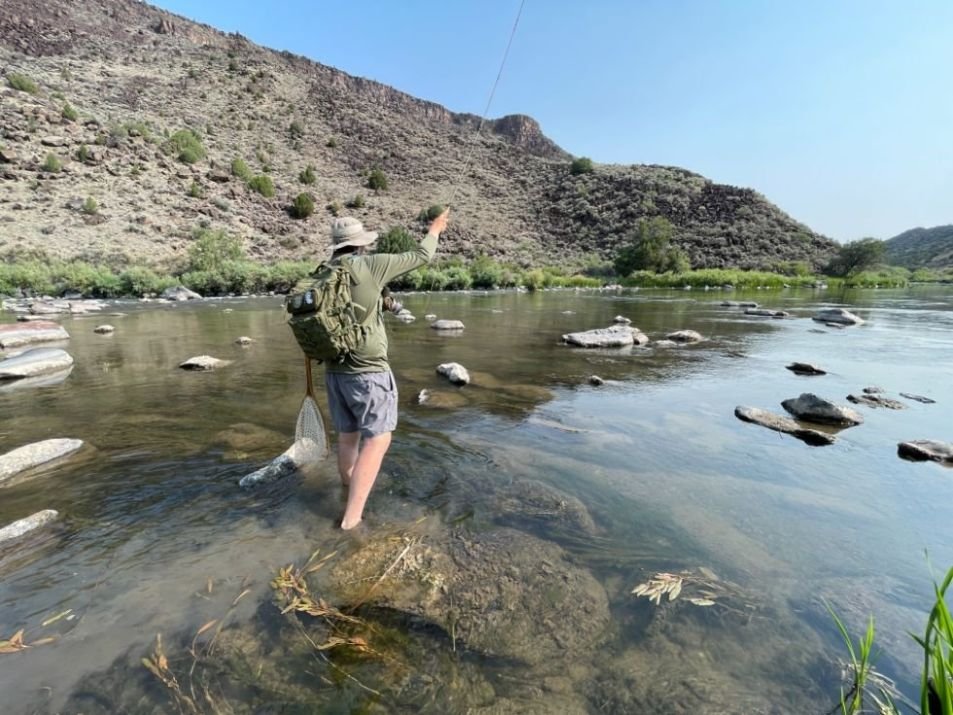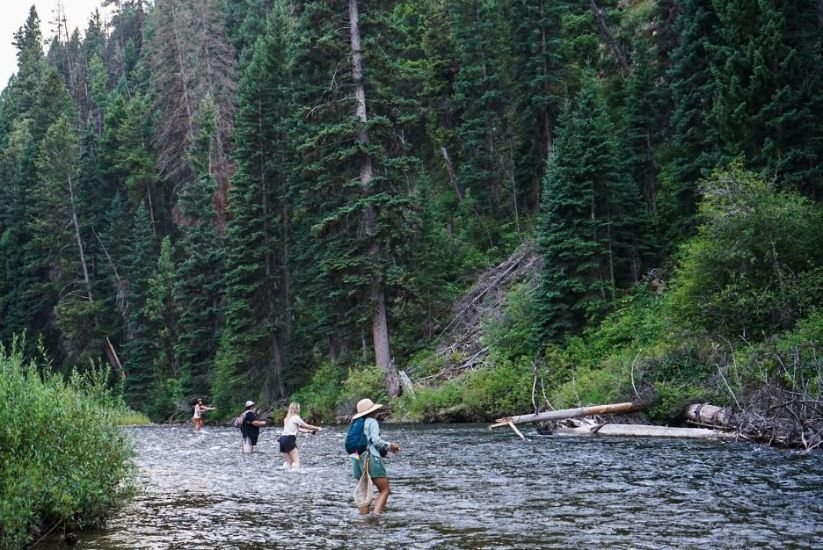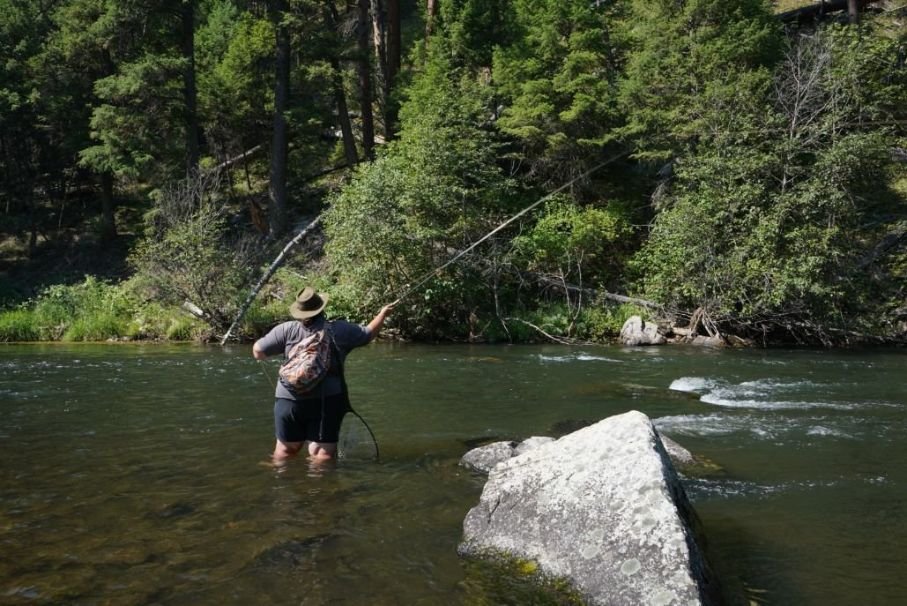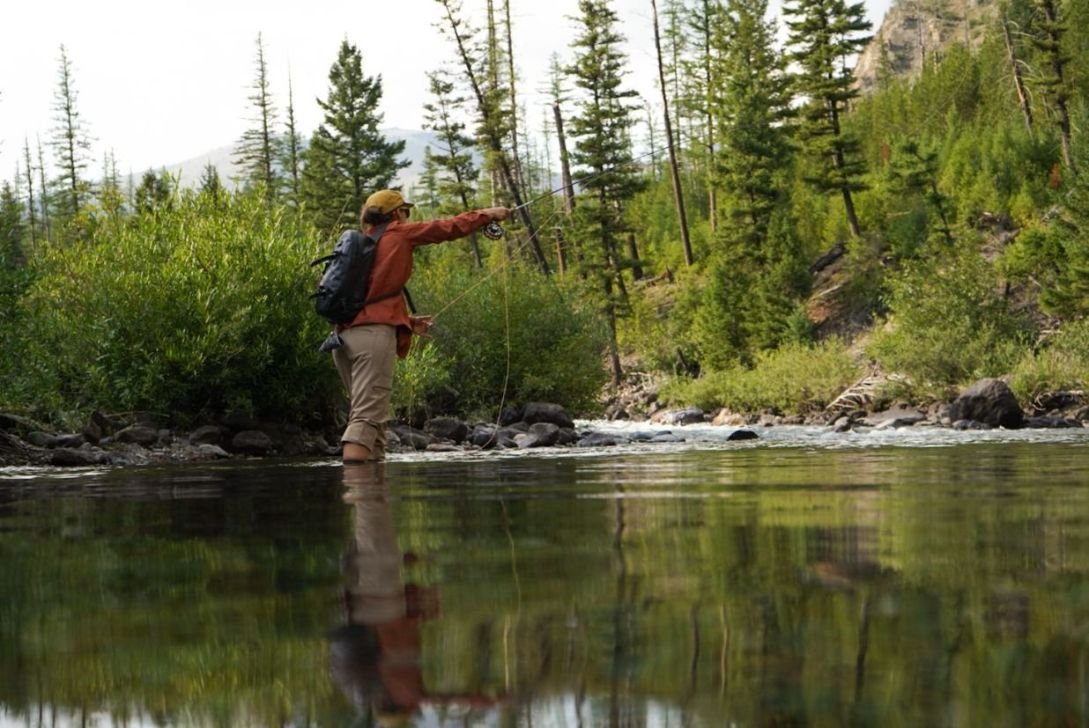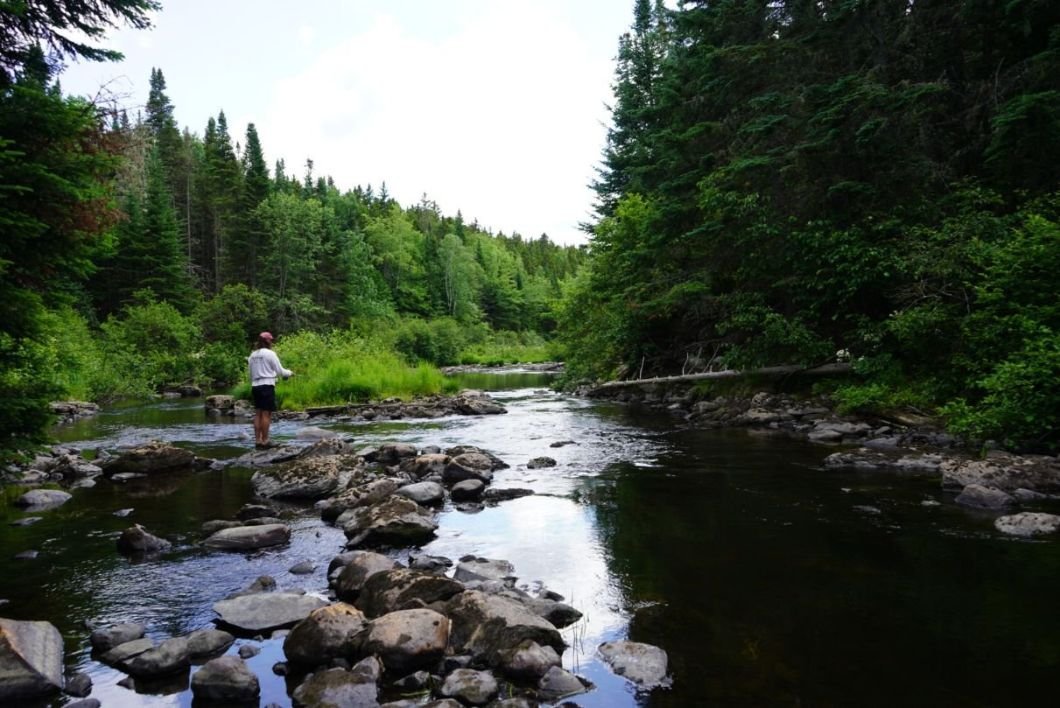Best Wet Wading Shoes for Fly Fishing of 2024
Lightweight Wet wading shoes and wading sandals: an alternative to fishing wading boots
The author Gabaccia Moreno sporting Astral Loyak AC wet wading shoes. Photo couretsy Gabaccia Moreno.
Home > Gear Reviews > Footwear
May 9th, 2024
From spring to early fall, anglers give their wading boots a break to catch fish with lighter and more comfortable gear: the wading shoe.
Wading shoes are what anglers wear standing and moving around the water. Wading shoes are lighter, more flexible, and less expensive than a wading boot. But wet wading shoes are also different than hiking shoes or creek crossing shoes that occasionally get wet. Instead, a wading shoe is comfortable enough to wear on water and land all day.
We researched and reviewed 23 of the best wet wading shoes for fly fishing, testing in waters from Minnesota to Mississippi to New Mexico. The best overall wet wading shoe is the men's and women's Salomon Amphib Bold 2, which is a functional shoe for land and water with a sleek design and reasonable price.
We create reader-supported, objective gear reviews independently selected by our editors. This story may contain affiliate links, which help fund our website. When you click on the links to purchase gear, we may get a commission — without costing you an extra cent. Thank you for supporting our work and mission of outdoor coverage for every body! Learn more.
Wet Wading Shoes Comparison Tables
Men’s Wet Wading Shoes
| MEN'S WADING SHOES | TREELINE AWARD | SOLE | CLOSURE | FEATURES | SIZES | WIDE SIZES? | WEIGHT (PAIR) | WARRANTY |
|---|---|---|---|---|---|---|---|---|
| Salomon Amphib Bold 2 | Best Overall Read why |
Contragrip FD | Quicklace | EVA sock liner, collapsible heel | 7-14 | N | 14.8 oz | 2-year limited |
| Astral Loyak AC Water Shoe | Best Water to City Read why |
G.15 rubber with Flex-Grip | Laces | Holes in midsole front and back for water drainage | 8-14 | N | [size 9] 13.2 oz | 1-year limited |
| Chaco Z/2 Classic | Best Wading Sandals Read why |
ChacoGrip rubber | Adjustable straps and buckle | Can be resoled; toe loop | 7-15 | Y | 23 oz | Lifetime |
| Simms Flyweight Shoe | Best Upgrade Read why |
Vibram Idrogrip rubber | Laces | Compatible with HardBite studs | 7-14 | N | 22.1 oz | Lifetime |
| NRS Workboot WetShoes | Rubber lug | Laces and ankle strap | Neoprene upper | 6-15 | N | 38.4 oz | n/a |
* Prices reflect MSRP and are subject to change. We note any discounts we see on our Deals page, which is updated daily.
Women’s Wet Wading Shoes
| WOMEN'S WADING SHOES | TREELINE AWARD | SOLE | CLOSURE | FEATURES | SIZES | WIDE SIZES? | WEIGHT (PAIR) | WARRANTY |
|---|---|---|---|---|---|---|---|---|
| Salomon Amphib Bold 2 | Best Overall Read why |
Contragrip FD | Quicklace | EVA sock liner, collapsible heel | 5-11 | N | 13.8 oz | 2-year limited |
| Astral Loyak AC Water Shoe | Best Water to City Read why |
G.15 rubber with Flex-Grip | Laces | Holes in midsole front and back for water drainage | 6-11 | N | [size 9] 13.2 oz | 1-year limited |
| Chaco Z/2 Classic | Best Wading Sandals Read why |
ChacoGrip rubber | Adjustable straps and buckle | Can be resoled; toe loop | 5-12 | Y | [size 7] 11.4 oz | Lifetime |
| Simms Flyweight Shoe | Best Upgrade Read why |
Vibram Idrogrip rubber | Laces | Compatible with HardBite studs | men's 7-14 | N | 20.1oz | Lifetime |
* Prices reflect MSRP and are subject to change. We note any discounts we see on our Deals page, which is updated daily.
Interested in fishing? See our fishing guides:
The Best Wet Wading Shoes
Best overall Water Shoe: Salomon Amphib Bold 2
Sole: Contragrip FD
Lacing System: Quicklace
Warranty: 2-year limited
Size Availability: Men 7-14, Women 5-11
What We Liked: Versatility, collapsible heel
What We Didn’t Like: On the narrow side
The Salomon Amphib Bold 2 offers a sleek design in a cross-functional shoe made for both land and water. The Amphib kept gravel and sand from her foot, still allowing her to feel light while moving through the water.
The features Ajani White, who tested these wet wading shoes on Minnesota waters, most appreciated were the breathable mesh upper. This feature kept her feet cool on warm days. She also liked the collapsible heel, which lets you wear them as slide-ins. While Salomon lists these shoes as built for “easy paths,” we found that they perform well while bushwhacking, rock scrambling, and the not-so-sure-what-to-expect social paths we sometimes take to access a river.
MEN'S SALOMON AMPHIB BOLD 2
WOMEN'S SALOMON AMPHIB BOLD 2
Design
The Salomon Amphib Bold 2's performance was complemented by their good looks. We found these shoes can work well with a jumper or jeans depending on the day. It made it easy to transition to the river anytime.
Performance
A bonus point for Ajani was that when she got caught in mud, the shoes stayed on thanks to their Quicklace™ technology (a drawstring type of shoelace) that provides a secure fit. The Salomon Amphib Bold 2 is also quick to dry, local-weather-pending, so there’s “no putting on damp shoes the next morning (yay!)” as shared by an excited reviewer on REI’s website (where it is now out of stock).
We couldn’t test the men’s version of these shoes, but we found that Amazon reviewers for women's and men's orders gave them similar ratings with 60% of women's orders giving them five stars and 61% of men's reviews giving them five stars. For the most part, men’s reviews under five stars included a dissatisfaction related to a previous-version comparison, often about sizing. Some men’s reviews claimed that these run slightly wider than the previous version, yet several people stressed that they are better for narrow feet.
Sizing
Many reviewers said they run true to size, but some also said they went up a half or full size; we think this trick may work best for folks with wider feet. Indeed, Ajani got them a half size larger, as she considers herself to have wider ankles, and the sizing worked well for her too. Ajani experienced rubbing on the top of her foot, and although it wasn't an issue, is something to keep in mind while sizing.
Wet wading in the Salomon Amphib Bold 2 means solid footing on slippery rocks in knee deep water.
Versatility
Other customer reviewers highlight the versatility of these shoes as all-around water and land must-haves.
Beyond wet wading, these have become Ajani’s go-to paddleboarding and drift boat fishing shoes. Other reviewers mentioned they also use them as camp shoes, for air travel, the gym, running, river rafting, kayaking, walking, and more.
The bottom line
The Amphib is a winner for its ease of transitioning from one fishing spot to another without trading out footwear, The Amphib wins our best overall with proven versatility. They've got all the functional features we want for a wet wading shoe, but also have a lot of versatility for other water sports.
They're also less expensive than fly fishing-specific models from brands like Simms and Orvis. Still, the Amphib has the technical upgrades that are worthwhile for comfort and ease in a wading shoe, especially when comparing it to budget options. If you can afford the splurge, the Amphib will get you where you need to be along the riverbank, road, and in the water.
Best Water to Pavement water shoe: Astral Loyak Ac Water Shoe
Sole: G.15 rubber with Flex-Grip
Lacing System: Laces
Warranty: 1-year limited
Size Availability: Men’s 8-14, Women’s 6-11
What We Liked: Kept the rocks out
What We Didn’t Like: On the narrow side
The Astral Loyak AC has a modern-yet-retro look that pairs as well with casual wear as with water wear. Many reviewers appreciate the ability to use them in different water-related activities such as paddle boarding, kayaking, fishing, boating, and more. Its predecessor, the Loyak, was named one of the “Best” water shoes by Outside Magazine. After several of our testers took the the Astral Loyak AC from New Mexico to Minnesota, we think these are the best wading shoes for people who want to function and fashion in their footwear.
The Astral Loyak AC shoe is versatile from performance to style. It performs well across different surfaces with a grippy rubber sole and a lightweight feel. It looks good with or without socks and feels comfortable with or without them. While it is best fitted for narrow feet, people with wide feet can size up for comfort. And ultimately, it makes a great alternative to an open-toe water shoe, having minimal water drag and leaving us with significantly fewer rocks in our shoes.
MEN's ASTRAL LOYAK AC
WOMEN's ASTRAL LOYAK AC
The author wore the Astral Loyak AC wet wading shoes with neoprene wading socks.
Lightweight
At first sight, the Astral Loyak AC look as lightweight as they are. Once I tried one on, I could immediately feel how durable the material was. I was nervous it wouldn’t have enough grip when looking at the tread, but once out on the water, I was proved wrong. These shoes performed well on both the stream and while cross country hiking to a waterfall where rock scrambling also put them to the test.
Astral Loyak AC vs. Loyak
The Astral Loyak AC differs from the original Astral Loyak (men’s and women’s) in a few ways. The Loyak AC is more technical with an ultrafine ripstop mesh and thermoplastic urethane reinforcements to guard against abrasion. The Loyak (not AC) is made of a waterproof canvas. The Loyak AC also has a sock-like entry better suited to keep out rocks. Both feature water drains in the front and back midsoles.
Gabaccia testing the Astral Loyak AC wet wading shoes. Photo by Roberto Flores.
Comfort
Because the Loyak AC so lightweight, you can feel the texture of the ground you are stepping on through these shoes. This feature may or may not be optimal for you, depending on your personal preference. We also tested these with and without a wading sock. While wearing a light wading sock, these continued to feel comfortable and allow for comfortable use in colder waters.
The bottom line
If you want to wet wading shoe that you can also wear when you're not fishing, the Astral Loyak is the best-looking option for using on water to pavement.
Best Wading Sandals: Chaco Z/2 Classic Sandals
Sole: ChacoGrip rubber
Lacing System: Adjustable straps and buckle
Warranty: Lifetime
Size Availability: Men’s 7-15, Women’s 5-12 (wide available)
What We Liked: Versatile and durable
What We Didn’t Like: Vulnerable to toe injury
The Chaco Z/2 Classic are the best wet wading sandals. Their thick, sturdy rubber sole means they're good for reaching access points. The Chaco Z/2 Classics also scored high for all-day comfort. Overall, the versatility and reliability of a Chaco sandal are what make us keep a pair around specifically for wet wade fishing. I, for one, spent my entire first year of fishing wet wading in a Chaco sandal that is five years old and still as functional as it ever was. We can also easily get behind a vegan-built shoe, and for that, we give Chaco extra points.
The Chaco Z/2 wins for fit and comfort as a wading shoe. “They fit like they were made just for me” reads one of the 400+ five-star reviews of these sandals on the Chaco website. Well, we feel similar. The beauty of the all-around adjustable straps makes these an easy choice for different widths of feet, while they also come in wide sizes too. The toe loop makes one’s steps feel safe and foot better connected to the footbed. That's one reason the Chaco Z/2 is also a winner in our Best Plus Size Outdoor Gear — because it's that comfortable for every body. The Chaco X/2 Classic is also a winner in our Best Hiking Sandals guide and our Best Plus Size Outdoor Gear guide.
MEN'S Z/2 CLASSIC BY CHACO
WOMEN'S Z/2 CLASSIC BY CHACO
Chaco Z/2 sandals are a great wet wading sandal option, although they do leave your toes exposed and in danger of getting stubbed. Photo by Roberto Flores.
Adjustable straps
Not to completely romanticize the strap system, as it can take some tries to find the right adjustments for one’s foot. The strap system is a dream for people with wider feet. We noticed that the buckle strap's end will hang a bit too long for those with very slim feet. As someone with slim feet, I usually wrap it around one of the side straps to keep me from feeling like I will step on it; I also know people who choose to clip the ends shorter.
Arch support and stability
The footbed of the Z/2® Classic provides solid arch support. They have a good balance of sturdiness and flexibility. The rubber sole provides confidence for the trail and rock scrambles around river banks. Several of our wading shoe testers have worn precursor Chaco models at some point in their wading lives, and durability has not been an issue.
Versatility
Depending on the temperature, one weakness of the shoe — as with any wading sandals — is that your toes and skin will be exposed to the elements. However, one workaround we appreciate for cooler days is that one can flatten and step on the toe loop to wear them as a combo with a wading socks for added temperature comfort.
Chaco Z/2 sandals have a toe loop that help secure the bottom of the shoe to your foot. Photo by Roberto Flores
Risks of sandals
One thing to keep in mind about wading sandals is that exposure has a safety impact. Tester Serene Cusack says, “It is not a matter of if, but when, a toenail injury will strike when wet wading in Chacos.” If that toe loop isn’t there, it could compromise the bottom of the shoe staying well attached to the angler’s foot on rocky and feisty river bottoms. If using these from a boat, an angler can get their fly line tangled on the end of the buckle strap. But in this case, you take some risks in exchange for the added comfort of wading sandals.
Best uses
But like with every shoe, we advise careful steps once in the water. As a category, wet wading sandals are best for casual trips or shorter, single-access fishing trips.
One tip Serene shared, though, which I support, is to save your Chacos for the not-very-technical water areas and shorter wet wade fishing outings. This will reduce the risks of stubbing a toe and lower the total number of toenails lost.
The bottom line
Throw a pair of Chacos in your car for when a creek looks too good to drive by, or a straightforward river would benefit from a few extra steps into the water to get your cast right into the honey hole.
Best Upgrade Wet Wading shoe: Simms Flyweight Wet Wading Shoe
Sole: Vibram Idrogrip rubber
Closure System: Laces
Warranty: Lifetime
Size Availability: Men’s 7-14
What We Liked: Lightweight, stud-compatible
What We Didn’t Like: Traction not great on submerged slippery rock, no women’s sizes
After months of testing on the Rio Grande in New Mexico, we think the Simms Flyweight Wet Wading Shoe is the best upgrade wet wading shoe, the best for long walk and wade days, and the best for covering the most river miles. It's a well-made endurance shoe with all the benefits of wading boots, but is far more lightweight and comfortable.
Simms Flyweight Wet Wading Shoe
Sims Flyweight wet wading shoe provides added protection and stability while fly fishing. Photo by Gabaccia Moreno.
Sturdiness
The Simms Flyweight Wet Wading shoes are sturdy enough to protect one’s feet well, featuring a solid Vibram sticky rubber sole ready to help you balance on those river rocks. In testing, they felt like they offer almost all the benefits of wading boots, but are far more lightweight. In fact, Simms offers the Flyweight as a wading boot, for those who want the extra ankle protection.
Bulk and weight
Wading boots, more often than not, feel heavy on the feet. In contrast, the Simms Flyweight Wet Wading Shoes are considerably less bulky than a wading boot, which adds comfort for long days on the river.
Quality
Immediately upon opening the Simms Flyweight Wet Wading Shoes, tester Roberto Flores thought to himself, "these are truly good quality shoes." The materials look and feel durable. Stepping into them, one can feel how securely they are built.
Fit and sizing
The fit itself is comfortable. We like how minimalist and direct the experience of using them is.
One thing to be aware of before purchasing these lightweight wading boots is to get the sizing right. Our tester Roberto has a very high arch and the ankle didn't fit correctly, so little rocks kept getting inside the shoe. If he were to do it again, he'd wear these shoes with wading socks to help mitigate the problem.
Sims Flyweight wet wading shoes are lightweight and sturdy. Photo by Gabaccia Moreno
An online reviewer on the Simms website said they successfully ordered a size and a half larger shoe to fit a neoprene wading sock with it. Many anglers find a neoprene sock helpful to add cushion and improve body temperature over extended use. Wearing a sock can also minimize how much your foot moves around in the shoe. Women’s sizes aren’t available, so if you wear women’s sizes, you will want to seek sizing advice from the brand or retailer directly.
Traction
We found that the Flyweight's traction is reliable on the trail but we found it can be challenging when walking on submerged slippery rock. Depending on what conditions and areas you are fishing, you may want to consider looking into Simms compatible wading boot studs specifically for this purpose.
The bottom line
The Simms Flyweight wet wading shoe is an excellent option for anyone who plans to have long wet wading days or hike longer distances to access water while bringing just one shoe. With the Flyweight, you can stay lighter on their feet while staying well-protected. For those looking for many of the benefits of a wading boot without the weight, these will make a solid choice.
Honorable Mentions
Orvis PRO Approach Shoe
Sole: Michelin Outdoor Extreme rubber
Closure System: Laces
Warranty: Lifetime
Size Availability: Men’s 7-14
What We Liked: Integrated Neoprene sock
What We Didn’t Like: Needed a break-in period
The Orvis PRO Approach Shoe is a rugged Crossfit-style sneaker-turned wading shoe. The design is simple yet functional. We appreciated the shoe's grip and protection. We also appreciated its lighter weight and style compared to a traditional wading boot or fly fishing boot. The Approach Shoe provides the right balance of internal security and outside grip to help an angler quickly suit up for the water and spend the day tooling around confidently.
Orvis Pro Approach Shoe
Design
Some of the Orvis Pro Approach Shoe's best features have to do with the design. We like the simple style, the ability to remove its 3D molded OrthoLite insoles, and the lace hood to keep laces out of the way.
The Orvis Pro comes with an integrated Ariaprene perforated neoprene sock that ensures debris does not get inside yet maintains a good level of breathability for its different possible uses.
Comfort
Our tester, Ashley White, liked the integrated sock and didn’t feel the need for anything else. However, some reviews on the Orvis website mentioned that the integrated sock could rub certain people’s feet and blister their heels. With this in mind, we tried to wear another sock, but found it challenging to do in combination with the included sock. One reviewer found a solution: use an ultralight merino wool sock as a liner. Another alternative is to size up and wear a light wading sock.
Ease of use
Several reviewers mentioned that the shoe itself was hard to get into; this difficulty is because the integrated sock is reinforced and lacks the stretch that allows for different foot shapes to get the shoes on comfortably. For people with high insteps, getting into these wading shoes could be tricky. Other folks found that it became easier to put them on after a few times.
Break-in
Something that stood out for Ashley was the lengthy break-in period necessary for the toe box and heel to mold well to his feet. Like a high-end pair of hiking boots, they have a break-in period but will last for years. For that reason, he thinks of these shoes as a shoe for the long haul, but isn't the pair to get if you need some shoes for a single trip scheduled for next weekend. “I would treat the shoe like I do my hiking boots when first purchased,” says Ashley.
Dry time
We tested these shoes in warm water urban river conditions in Mississippi. They dry fast in two phases. In phase 1, there was no visible water after a few minutes, and in phase 2, they were dry to the touch in about four hours if exposed to complete sunlight. They are only available in Men’s sizes, and they fit true to size.
Sole: Rubber lug
Closure System: Laces and ankle strap
Size Availability: Men’s 6-15
What We Liked: Traction, comfort
What We Didn’t Like: Integrated sock not for everyone
Depending on who you are, the NRS Workboot Wetshoes might just make you feel like a secret agent confidently pushing through waters, or like a competition jazz dancer leaping and sashaying through the river. These alternatives to ultralight wading boots were tested by Sarah Burtis at Button Rock Creek in Lyons, CO in late fall. She wore a thin sock in addition to the Neoprene sock that’s integrated, and it worked great for her hike to the creek, during which she describes having felt “extremely comfortable.”
Nrs Workboot Wetshoes
NRS Workboot Wetshoes are a loved shoe by many kayakers and work great for wet wading while fly fishing. Photo by Sarah Burtis.
Traction
Many reviewers on the NRS website and Amazon praise how grippy these lightweight wading boots are around the water. Sarah says she had “no issues with traction on otherwise slippery rocks.” Several kayakers (from consumer reviews) swear by these boots as they fit well in their limited space while keeping them safe when loading/unloading their kayaks.
Some reviews online mentioned that these wading boots have longer drying times, but Sarah found that they dried quickly in an arid environment when left in the sun.
Comfort and sizing
These wading boots are available in men’s sizes only and run very small. Sarah originally ordered them in her true size but exchanged them for the next size up. Several other online reviewers did the same, and some even had to go up 2 sizes to find their better fit. A few who only went up a half size shared that they fit snug but not uncomfortably; keep in mind that this probably wouldn’t work for folks wanting to add an extra sock to the equation.
Ease of use
The integrated sock was a deal-breaker for some users because it increased difficulty getting them on and off. Other people didn’t think it was that difficult. We can understand this is an issue that depends, yet again, on the shape of one’s foot. Sarah points out that while having the integrated neoprene sock, the shoes didn’t keep her feet as warm as she expected. That’s the only reason her experience at the river wasn’t as comfortable as on the trail.
Salomon Tech Amphib 5
Sole: Water Contragrip
Closure System: Quicklace
Size Availability: 7-14 (men's) and 5-11 (women's)
What We Liked: fit, comfort, technical features, feels like a step up from the Amphib bold
What We Didn’t Like: We’re still testing!
The Salomon Tech Amphib 5 is designed for use in wet terrain. It's quick drying with breathable materials and has a reinforced toe cap useful for walking in rocky creeks.
Like the Salomon Amphib Bold, it has a collapsible heel for slipping in and out. It has a more casual look than the Amphib Bold and can be used in other outdoor activities. We're currently testing the Amphib 5 and will report back on what we find—but so far, it looks promising.
Men's
Women's
What is a wading shoe?
Wet wading season runs from late, late spring to early fall (depending on personal temperature tolerance and local weather). Wet wading season is when anglers all around give their waders and wading boots a break to get out and catch fish in lighter gear. Enter the wading shoe!
Wet wading is often done in waders, as seen in this photo of the Patagonia waders. However, waders are costly and have limited sizing availability. The wet wading shoe can help. Photo by Bri Dostie.
What is wading?
Wading is the craft of navigating by foot through lakes, surf, streams, and rivers. Each place will have specific challenges and needs when choosing the proper footwear. Wading shoes are different from hiking or creek crossing shoes that occasionally get wet: wading shoes need to be something an angler can spend an entire day (or night) in, standing and moving around in the water. Having a good wading shoe can be the difference between a great and safe time fishing and an unnecessarily sore, hurt, or broken [enter suffering body part here].
When it comes to choosing which shoe may be the best fit for you, this depends very much on the type of water you frequent most: are you spending time in small creeks, large raging rivers with strong currents, brackish tidal marshes, or still water shorelines? The ideal shoes for each location vary, with different demands for fit, traction, breathability, and so forth. To better help you decide, we’ve tested a variety of shoes across different waters from East to West.
Wet wading shoes are perfect fly fishing shoes to use from early spring through fall and are a welcome lightweight alternative to waders and wading boots. Photo by Gabaccia Moreno.
How we researched
We compiled this review of wading shoes based on the feedback of anglers from across the United States. We asked them to fish and adventure in varied conditions. Walk and wade fishing is an accessible way to get a line on the water, though for some, it’s only an option in warm weather due to inaccessible pricing and sizing for waders. While this remains a barrier, our gear testers are particularly accustomed to walking and fishing in water without waders, have stubbed plenty of toes on rocks, slipped, lost balance, and even sometimes successfully navigated a river in wading shoes.
Given these experiences (and bruises), we have a good sense of what to look for in wading shoe durability, structure, toe protection, traction, and beyond. Even better: we pulled our top picks for field testing after extensive research into market offerings.
Before selecting models for field tests, we reviewed content from outdoor review entities like Outdoor Gear Lab, Gear Institute, Heavy, Trailspace, and fly fishing gear reviewers. We also pulled from retail site reviews like Amazon, Backcountry, REI, and more. Since most fly fishing gear reviews come from white male writers, our community approach for this piece aims to shift that perspective norm - something we’ll continue in future fishing-related reviews.
A group of anglers wet wading in Montana at the Outcast Anglers event with Confluence Collective. Photo by Bri Dostie.
How we tested
Each tester took a different pair of shoes on one or several adventures to gather helpful intel on their performance: from fishing off the side of the highway to the backcountry, on rivers, streams, and lakes.
We incorporated feedback from anglers with access points from New Mexico, Minnesota, Colorado, and Montana. These fishing spots varied in all the ways rivers manifest-fast and slow currents, freestone river bottoms, mucky sediment, slippery rocks, mixed vegetation, and so forth.
By testing in varied conditions, we could determine which features and characteristics were most beneficial in each setting-and guide you to identifying what your needs might be based on the characteristics of water close to you.
Serene Cusack wet wading in Montana. Photo by Bri Dostie.
Testing Criteria
We considered drying times for each shoe by checking its average drying times. Drying time varies depending on the local climate, temperature, and humidity, but each review will be specific about what to expect for that shoe depending on the environment we tested it in.
This criterion should help deduce how a particular shoe might perform elsewhere. For example, we tested some of the shoes in the high desert of New Mexico; we couldn’t try to compare drying times there to the shoes that we tested in Michigan. Keep in mind-it’s all relative.
Bri Dostie wet wading in Montana. Photo by Julie Ellison.
Buying advice
Here’s what makes a good wet wading shoe and the criteria we used to judge from the dozens of models out there.
Price range: $50-$100
One of the advantages of choosing wading shoes over a fly fishing wading boot or waders is the price. While the best wading boot options can run up to $300, the highest-end wading shoe will be about half that price.
We think between $50 to $100 is a reasonable price for a wading shoe. In our testing, we found that a product's durability seems to decline significantly when spending less. This results in more purchases required over time, and ultimately is less sustainable.
On the other hand, you can spend more than $100 on a wading shoe, but we think that you won’t be gaining any additional features aside from maybe better style.
Size availability and men’s and women’s option
We like to address sizing options to be inclusive to outdoor folks of all body types. Not all of these have inclusive options, but we’ll call them out on each review.
Drainage or drying time
A fast-drying shoe is crucial because it minimizes the chances of mold around your belongings. With that said, the drying time will depend as much on the shoe's composition as on the climate.
Weight range
A good weight range of the shoes will depend on personal preference more than anything. A shoe made of heavier materials might indeed last longer. But, if you are not comfortable wearing heavy shoes, you will not have a good time while fishing. Something to note is that wading shoes are the lightweight alternative to the classic yet more bulky and sturdy wading boots (review coming soon).
Lacing/Lacing systems
We found a range of traditional lacing systems, twist cinches, velcro, and well-placed straps on the wet wading shoe and fishing boots market.
Why is this important for different types of fishing? Depending on the type of fishing you most frequently partake in, different lacing systems may suit you better. Here are some examples to put this into perspective:
Having to re-tie traditional laces in strong river currents can be annoying.
Cinch systems can sometimes clog with fine sediment in still water. This may be detrimental to the longevity of the shoe.
Insecure and less form-fitting straps may be unable to keep a shoe on your foot in fast water or slippery rocks.
Velcro (hook and loop) systems can inadvertently transport microorganisms to and from sensitive watersheds. You'll need to scrub them out velcro to avoid introducing microorganisms to new watersheds. This can be an extra chore that you may not want to do every time you fish somewhere new.
With all of that in mind, different conditions will favor one system over another, making the cinch system an essential consideration for your purchase.
Durability
If a wading shoe lasts me for 2 years, then I’m happy. But that’s for someone like me, who would wear this shoe every weekend for half of the year, which is a lot. For occasional anglers, you may find that a good shoe can last you a very long time.
Environmental Sustainability
This consideration goes beyond the use of sustainable materials or the overall durability of a shoe product.
Sustainability also recognizes the sensitive nature of recreating in aquatic environments and aims to minimize our environmental footprint with our movements in these natural spaces. Having the right shoe can make our interactions less stressful on an environment-or alternately, leave a lasting impact well beyond our presence.
The ability to clean shoes between uses in different locations is big; we gave bonus points for shoes that dry thoroughly to avoid growing bacteria or transporting organisms in the back of a car trunk. If you’re familiar with the wet waders funk of late summer in your car, anticipate similar odors if you don’t air out your wading shoes or rinse between uses. Having shoes that hold up to rinse and repeat over time is beneficial for your wallet and the ecosystems you wade into.
Traction
Part of wet wading is trying to move and keep your balance on slippery rocks and in swift moving water in creeks and rivers. Traction is essential to staying safe and upright so you can focus on fishing. Different wet wading shoes use different technology to do this. Some brands use name brand outsoles like Vibram. Others use their own proprietary soles.
Grip
The grip you find on a wet wading shoe is sometimes different than on a hiking shoe or hiking boot. Wet wading shoe grip is designed for mud and slippery wet rocks and not loose, dry steep trails. While most wet wading shoes will have decent grip for dry climates as you likely will have to descend a dry bank to reach the water, the best wet wading shoes must have good grip for when you’re in the river.
Protection
When you’re standing in the river, your feet will be exposed to pointy rocks, sticks, and debris that may be floating in the water or at the bottom of the water. Wet wading shoes not only keep you more stable while walking and standing in the river, but keep your feet and toes from being cut. Most of the wet wading shoes we recommend come with ample protection for toes with the exception of the best wet wading sandals. If you choose wet wading sandals, just know the trade-offs. You’ll sacrifice some protection for comfort.
What lacing system should I get for my wet wading shoes?
Here are our recommendations for what will work best for your most frequently fished spots:
Laces
Laces are best for semi-aquatic fishing such as perched on rocky riverbanks rather than actually standing in current for long periods. Also, laces work well for use in rivers where minimal debris can be caught in them while taking steps in the water or underbrush.
Velcro and Adjustable Straps
Velcro (also called hook-and-loop) and adjustable strap systems are best for anglers wading in fast currents and resilient ecosystems.
Cinch
A cinch lacing system is best for those who change footwear between access points, for quick and secure sizing, and use in spaces without fine sediment.
Care and maintenance of wet wading shoes for fly fishing
Each wet wading shoe is different, but in general, these are instructions to keep your shoes clean and durable for several seasons. Check the instructions on your particular shoe for details.
Cleaning
After each use, rinse off any dirt, sand, algae, or other debris from your wet wading shoes using clean water. This is especially true if you are taking your wet wading shoes into salt water.
Use a soft brush or cloth to gently scrub away stubborn dirt or stains.
If needed, you can use mild soap or a footwear cleaner specifically designed for outdoor shoes. Follow the manufacturer's instructions for cleaning the shoes.
Avoid using harsh chemicals or bleach, as they can damage the materials of the shoes.
Drying
After cleaning, allow your wet wading shoes to dry completely. This helps prevent the growth of mold, mildew, and odors.
Remove any insoles or footbeds and let them air dry separately.
Avoid using direct heat sources such as heaters or direct sunlight, as they can melt or damage the materials. Instead, let them air dry at room temperature.
Stuff the shoes with crumpled newspaper or use a shoe tree to help them maintain their shape during the drying process.
Storage
Before storing your wet wading shoes, ensure they are completely dry to prevent moisture build-up, development of mold and odor, and other potential damage.
Store them in a cool, dry, and well-ventilated area to avoid the growth of mold or mildew.
Consider using a shoe bag or a breathable mesh bag to protect them from dust and keep them organized.
Avoid storing wet wading shoes in sealed plastic bags, as this can trap moisture and lead to unpleasant odors.
Maintenance
Regularly inspect your wet wading shoes for any signs of wear, such as worn outsoles, loose stitching, or damaged materials.
Repair any minor issues promptly to prevent them from worsening. Some repairs can be done using shoe adhesives or by taking them to a professional shoe repair service.
Consider applying a waterproofing treatment or reapplying it periodically to maintain water resistance.
FAQ
What is the difference between wet wading shoes and regular fishing shoes?
Most people think of “regular fishing shoes” as waders. Waders are generally taller rubber boots attached to what looks like overalls. The reason waders aren’t a good option for wet wading and some types of fly fishing is they are expensive and they get hot. During summer, many anglers in many climates will be happier wet wading (fishing from the bank or standing in the river while wearing wet wading shoes).
Basically think of waders as cold weather gear. In contrast, wet wading shoes are for warm and hot weather.
Do I need special socks or booties with wet wading shoes?
Whether you wear socks with your wet wading shoes depends on the design of the shoe, the season, temperature of the water, and also is a personal preference.
If you do wear socks with your wading shoes, size up! Many wet wading shoes are sized assuming you are not wearing socks.
Confluence Collective angler Sarah Burtis says, “I wear wading socks with my wading boots when I’m wet wading. I feel like they would be pretty loose and uncomfortable if I tried to wear wading boots without wading socks but I’m sure people do it. If you are wet wading with shoes like Astrals [editor’s note: which we recommend above], you should be okay to not wear wading socks.” In fact, the Astrals are designed to not be worn with socks, so if you want to wear socks, size up on your shoes!
Can I wear wet wading shoes without waders?
Yes, wet wading shoes are alternatives to waders or bulkier wading boots. Many people wear wading boots with their waders in cold temperatures or in the winter. But wet wading shoes are usually used in warmer water.
Wet wading shoes really aren’t wading boots and wouldn’t really fit over waders at all in most cases.
Can wet wading shoes be used for other water activities?
Yes! At least one of our winning wet wading shoes are also recommended in our Best Hiking Sandals guide. If the shoes are comfortable and have the traction and durability you need for the activity, then they are appropriate.
Can I use wet wading shoes in saltwater environments?
Yes! However, as with any gear entering salt water, be sure to wash it off and dry completely after use.
The author Gabaccia Moreno by a creek wearing the Astral Loyak AC wet wading shoes. Photo by Roberto Flores.
About the Author/Why The Reader Should Trust Us
This guide is shaped by the lived experiences of several anglers. We are all connected through a love of fly fishing, and collectively we have caught many fish over four decades of practice. Some of our testers are fishing guides, and some do it recreationally (and obsessively, to be fair). We’ve tasked each person with the shoe we thought would be best for their fit and location. We also made sure not to overlap any pre-existing ambassadorships with our testers to give you the most unbiased review possible.
Gabaccia Moreno compiled the field testing results and collective experiences for this guide. Gabaccia is a first-generation Mexican-American outdoor equity advocate and multi-disciplinary storyteller #ExploringResponsibly wherever life takes her.
You can read more about Gabaccia on her website.
I am not sponsored, an ambassador, or an employee of any of the companies mentioned here. This review is unbiased, and we do this to help you find the best product for the price. Treeline Review doesn’t accept sponsored content, native advertising, or paid reviews.

